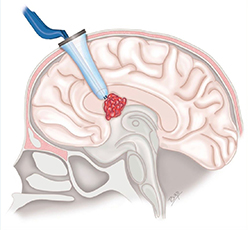A craniotomy is an intricate neurological procedure performed by opening the skull, performing the needed surgery, and closing the skull by securing the bone into its original position. An awake craniotomy, or awake brain surgery, is a minimally invasive surgery where the patient is awake during the procedure. Awake craniotomies require less bone removal and limit the injury done to surrounding brain tissue, significantly reducing the impact on your quality of life.

Expert neurosurgeons at the University of Miami Health System use awake craniotomies to remove complex brain tumors while working to preserve speech and language function. We are one of only a handful of neurosurgeons in the United States who perform awake craniotomies.
What is a Complex Brain Tumor?
A complex brain tumor is an abnormal growth in the brain that is close to critical areas, such as near those areas of that brain that control speech and movement. Removing only the tumor — while preserving precious brain tissue and bodily function — is a complicated procedure that can only be successfully performed by expert neurosurgeons.
Who is a Candidate?
If you have a complex brain tumor, your neurosurgeon may recommend you undergo an awake craniotomy to help preserve your speech and language abilities.
What to Expect
During an awake craniotomy, our neurosurgeons and neurologists use advanced brain-mapping techniques to identify and avoid injury to the sites of language, motor, and sensory function. We do this by using electrical currents to stimulate specific areas of the brain, and then using imaging to determine if that electrical current is impacting the brain area. For example, when a tumor is near critical speech areas of the brain, it is important to determine the exact location of these speech-related areas to avoid affecting them.
An awake craniotomy is performed on an inpatient basis in the hospital, meaning that you’ll expect to spend the night after your procedure. You will be under full anesthesia (asleep) when the procedure begins. Your surgeon will make an incision in your head near the area of skull they need to remove temporarily to reach the tumor.
Once your neurosurgeon reaches the area of your brain where the tumor is, the sedation will be slowly lifted to allow you to be “awake” and communicate with your surgical team. Our specialists use imaging techniques – such as magnetic resonance imaging (MRI) or computerized tomography (CT) scans – to locate the exact areas of the brain used for language, muscle skills, and sensation.
Your neurosurgeon will ask you to talk, move, and follow commands. If the electric stimulation affects your ability to perform any of these tasks, then the surgeon knows to avoid the area and leave it intact because it is not affected by the tumor. Once the tumor is removed, you will be sedated again while the surgeon finishes the operation. Your skull will be placed back in position, and the incision will be closed with stitches and covered with a sterile dressing.
After the procedure, you will be monitored closely for 24 to 48 hours. You should be able to eat, drink, and move around – with help – soon after the procedure. You will likely return home from the hospital a few days after the awake craniotomy, and then see your neurosurgeon for a post-operative visit about a week later.
Questions? We're here to help.
Our appointment specialists are ready to help you find what you need. Contact us today.